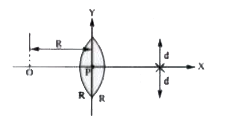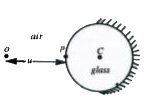ADDITIONAL PRACTICE EXERCISE (LEVEL-II PRACTICE SHEET (ADVANCED) STRAIGHT OBJECTIVE TYPE QUESTIONS) from AAKASH SERIES Chapter 18 GEOMETRICAL OPTICS for Class 12
| Class 12 | PHYSICS |
| Chapter | GEOMETRICAL OPTICS |
| AAKASH SERIES | ADDITIONAL PRACTICE EXERCISE (LEVEL-II PRACTICE SHEET (ADVANCED) STRAIGHT OBJECTIVE TYPE QUESTIONS) |
| Medium | English |
| Academic Year | 2023-2024 |
Question 3
An under water swimmer is at a depth of 12 m below the surface of water. A bird is at a height of 18 m from the surface of water, directly above his eyes. For the swimmer the bird appears to be at a distance from the surface of water equal to (Refracting index of water is 4/3)View SolutionQuestion 7
A ray of light is incident on the face AB of a glass prism ABC having vertex anlge A equal to 30∘. The face AC is silvered and a ray of light incident on the face AB retraces its path. If the refractive index of the material of prism is √3 find the angle of incidence on the face AB.View SolutionQuestion 9
A ray of light is incident on the hypotenuse of a right-angled prism after travelling parallel to the base inside the prism. If μ is the refractive index of the material of the prism, the maximum value of the base angle for which light is totally reflected from the hypotenuse is View SolutionQuestion 11
A ray of light travelling in glass having refractive index _(a)μg=3/2 is incident at a critical angle C on the glass air interface. If a thin layer of water is poured on glass air interface, then what will be the angle of emergence of this ray in air when it emerges from water air inteface?View SolutionQuestion 14
The n transparent slabs of refractive index1.5 each having thickness 1cm, 2 cm,…to n cm are arranged one over another. A point object is seen through this combineation with near perpendicular light. If the shift of object by the combination is 1 cm, then find the value of n. View SolutionQuestion 20
Light is incident on the thin lens as shown in figure. The refractive index of the material of the lens is μ2. The radii of curvature of both the surfaces are R. The refractive index of the medium of left side is μ1, while that of right side is μ3. What is the focal length of the lens?
 View Solution
View SolutionQuestion 22
A convex lens is placed between an object and a screen which are at a fixed distance apart for one position of the lens. The magnification of the image obtained on the screen is m1. When the lens is moved by a distance d the magnification of the image obtained on the same screen m2, Find the focal length of the lens.View SolutionQuestion 23
A thin biconvex lens of refractive index 3/2 is placed on a horizontal plane mirror as shown in Figure . The space between the lens and the mirror is then fille with water or refractive index 4/3. It is found that when a point object is placed 15 cm above the lens on its principal axis, the object coincides with its own image. On representing with another liquid, the object and the image again coincide at a distance 25 cm from the lens. Calculate the refractive index of the liquid.
 View Solution
View SolutionQuestion 24
A convex lens is placed between an object and a screen which are at a fixed distance apart for one position of the lens. The magnification of the image obtained on the screen is m1. When the lens is moved by a distance d the magnification of the image obtained on the same screen m2, Find the focal length of the lens.View SolutionQuestion 27
A double convex lens forms a real image of an objectt on a screen which is fixed. Now lens is given a constant velocity v=1m/s along its axis and away from the screen for the purpose of forming image always on the screen the object is also required to be given appropriate velocity . Find the velocity (in m/s) of the object at the instant its size is doubled the size of the image. View SolutionQuestion 29
A biconvex thin lens of radius of curvature R is made up of variable refractive index μ=2(1+rd). Assume 2d<<R. There are infinite images of the point O, which is placed at a distance R on the principal axis from the lens as shown in the figure. The image is spread along the pricipal axis in a length of (r is the radial distance from P measured perpendicular to principal axis)
 View Solution
View Solution
All Exercises from AAKASH SERIES Class 12 PHYSICS GEOMETRICAL OPTICS
- ADDITIONAL PRACTICE EXERCISE (LEVEL-I (MAIN) STRAIGHT OBJECTIVE TYPE QUESTIONS)
- ADDITIONAL PRACTICE EXERCISE (LEVEL-II LECTURE SHEET(ADVANCED) INTEGER TYPE QUESTIONS)
- ADDITIONAL PRACTICE EXERCISE (LEVEL-II LECTURE SHEET(ADVANCED) LINKED COMPREHENSION TYPE QUESTIONS)
- ADDITIONAL PRACTICE EXERCISE (LEVEL-II LECTURE SHEET(ADVANCED) MATRIX MATCHING TYPE QUESTIONS)
- ADDITIONAL PRACTICE EXERCISE (LEVEL-II LECTURE SHEET(ADVANCED) MORE THAN ONE CORRECT ANSWER TYPE QUESTIONS)
- ADDITIONAL PRACTICE EXERCISE (LEVEL-II LECTURE SHEET(ADVANCED) STRAIGHT OBJECTIVE TYPE QUESTIONS)
- ADDITIONAL PRACTICE EXERCISE (LEVEL-II PRACTICE SHEET (ADVANCED) INTEGER TYPE QUESTIONS)
- ADDITIONAL PRACTICE EXERCISE (LEVEL-II PRACTICE SHEET (ADVANCED) LINKED COMPREHENSION TYPE QUESTIONS)
- ADDITIONAL PRACTICE EXERCISE (LEVEL-II PRACTICE SHEET (ADVANCED) MATRIX MATCHING TYPE QUESTIONS)
- ADDITIONAL PRACTICE EXERCISE (LEVEL-II PRACTICE SHEET (ADVANCED) MORE THAN ONE CORRECT ANSWER TYPE QUESTIONS)
- ADDITIONAL PRACTICE EXERCISE (LEVEL-II PRACTICE SHEET (ADVANCED) STRAIGHT OBJECTIVE TYPE QUESTIONS)
- ADDITIONAL PRACTICE EXERCISE -I (LEVEL-I(MAIN) STRAIGHT OBJECTIVE TYPE QUESTIONS)
- ADDITIONAL PRACTICE EXERCISE -I (LEVEL-II LECTURE SHEET (ADVANCED) INTEGER TYPE QUESTIONS)
- ADDITIONAL PRACTICE EXERCISE -I (LEVEL-II LECTURE SHEET (ADVANCED) LINKED COMPREHENSION TYPE QUESTIONS)
- ADDITIONAL PRACTICE EXERCISE -I (LEVEL-II LECTURE SHEET (ADVANCED) MATRIX MATCHING TYPE QUESTIONS)
- ADDITIONAL PRACTICE EXERCISE -I (LEVEL-II LECTURE SHEET (ADVANCED) MORE THAN ONE CORRECT TYPE QUESTIONS)
- ADDITIONAL PRACTICE EXERCISE -I (LEVEL-II LECTURE SHEET (ADVANCED) STRAIGHT OBJECTIVE TYPE QUESTIONS)
- LECTURE SHEET (EXERCISE I LEVEL -I (MAIN) STRAIGHT OBJECTIVE TYPE QUESTIONS)
- LECTURE SHEET (EXERCISE I LEVEL -II (ADVANCED) INTEGER TYPE QUESTIONS)
- LECTURE SHEET (EXERCISE I LEVEL -II (ADVANCED) LINKED COMPREHENSION ANSWER TYPE QUESTIONS)
- LECTURE SHEET (EXERCISE I LEVEL -II (ADVANCED) MATRIX MATCHING ANSWER TYPE QUESTIONS)
- LECTURE SHEET (EXERCISE I LEVEL -II (ADVANCED) MORETHAN CORRECT ANSWER TYPE QUESTIONS)
- LECTURE SHEET (EXERCISE I LEVEL -II (ADVANCED) STRAIGHT OBJECTIVE TYPE QUESTIONS)
- LECTURE SHEET (EXERCISE II LEVEL -I (MAIN) STRAIGHT OBJECTIVE TYPE QUESTIONS)
- LECTURE SHEET (EXERCISE II LEVEL -II (ADVANCED) INTEGER TYPE QUESTIONS)
- LECTURE SHEET (EXERCISE II LEVEL -II (ADVANCED) LINKED COMPREHENSION TYPE QUESTIONS)
- LECTURE SHEET (EXERCISE II LEVEL -II (ADVANCED) MATRIX MATCHING TYPE QUESTIONS)
- LECTURE SHEET (EXERCISE II LEVEL -II (ADVANCED) MORE THAN ONE CORRECT TYPE QUESTIONS)
- LECTURE SHEET (EXERCISE II LEVEL -II (ADVANCED) STRAIGHT OBJECTIVE TYPE QUESTIONS)
- LECTURE SHEET (EXERCISE III LEVEL -I (MAIN) STRAIGHT OBJECTIVE TYPE QUESTIONS)
- LECTURE SHEET (EXERCISE III LEVEL -II (ADVAMCED) INTEGER TYPE QUESTIONS)
- LECTURE SHEET (EXERCISE III LEVEL -II (ADVAMCED) LINKED COMPREHENSION TYPE QUESTIONS)
- LECTURE SHEET (EXERCISE III LEVEL -II (ADVAMCED) MATRIX MATCHING TYPE QUESTIONS)
- LECTURE SHEET (EXERCISE III LEVEL -II (ADVAMCED) MORE THAN ONE CORRECT TYPE QUESTIONS)
- LECTURE SHEET (EXERCISE III LEVEL -II (ADVAMCED) STRAIGHT OBJECTIVE TYPE QUESTIONS)
- LECTURE SHEET (EXERCISE-I (LEVEL-I (MAIN) STRAIGHT OBJECTIVE TYPE QUESTIONS))
- LECTURE SHEET (EXERCISE-I (LEVEL-II (ADVANCED) INTEGER TYPE QUESTIONS))
- LECTURE SHEET (EXERCISE-I (LEVEL-II (ADVANCED) LINKED COMPREHENSION TYPE QUESTIONS))
- LECTURE SHEET (EXERCISE-I (LEVEL-II (ADVANCED) MATRIX MATCHING TYPE QUESTIONS))
- LECTURE SHEET (EXERCISE-I (LEVEL-II (ADVANCED) MORE THAN ONE CORRECT ANSWER TYPE QUESTIONS))
- LECTURE SHEET (EXERCISE-I (LEVEL-II (ADVANCED) STRAIGHT OBJECTIVE TYPE QUESTIONS))
- LECTURE SHEET (EXERCISE-II (LEVEL-I (MAIN) STRAIGHT OBJECTIVE TYPE QUESTIONS))
- LECTURE SHEET (EXERCISE-II (LEVEL-II (ADVANCED) INTEGER TYPE QUESTIONS))
- LECTURE SHEET (EXERCISE-II (LEVEL-II (ADVANCED) LINKED COMPREHENSION TYPE QUESTIONS))
- LECTURE SHEET (EXERCISE-II (LEVEL-II (ADVANCED) MATRIX MATCHING TYPE QUESTIONS))
- LECTURE SHEET (EXERCISE-II (LEVEL-II (ADVANCED) STRAIGHT OBJECTIVE TYPE QUESTIONS))
- LECTURE SHEET (EXERCISE-III (LEVEL-I (MAIN) STRAIGHT OBJECTIVE TYPE QUESTIONS))
- LECTURE SHEET (EXERCISE-III (LEVEL-II (ADVANCED) INTEGER TYPE QUESTIONS))
- LECTURE SHEET (EXERCISE-III (LEVEL-II (ADVANCED) LINKED COMPREHENSION TYPE QUESTIONS))
- LECTURE SHEET (EXERCISE-III (LEVEL-II (ADVANCED) MATRIX MATCHING TYPE QUESTIONS))
- LECTURE SHEET (EXERCISE-III (LEVEL-II (ADVANCED) MORE THAN ONE CORRECT ANSWER TYPE QUESTIONS))
- LECTURE SHEET (EXERCISE-III (LEVEL-II (ADVANCED) STRAIGHT OBJECTIVE TYPE QUESTIONS))
- PRACTICE SHEET (ADVANCED) (INTEGER TYPE QUESTIOS)
- PRACTICE SHEET (ADVANCED) (LINKED COMPREHENSION CORRECT TYPE QUESTIOS)
- PRACTICE SHEET (ADVANCED) (MATRIX MATCHING TYPE QUESTIOS)
- PRACTICE SHEET (ADVANCED) (MORE THAN ONE CORRECT TYPE QUESTIOS)
- PRACTICE SHEET (ADVANCED) (STRAIGHT OBJECTIVE TYPE QUESTIOS)
- PRACTICE SHEET (EXERCISE I LEVEL -I (MAIN) STRAIGHT OBJECTIVE TYPE QUESTIONS)
- PRACTICE SHEET (EXERCISE I LEVEL -II (ADVANCED) INTEGER TYPE QUESTIONS)
- PRACTICE SHEET (EXERCISE I LEVEL -II (ADVANCED) LINKED COMPREHENSION TYPE QUESTIONS)
- PRACTICE SHEET (EXERCISE I LEVEL -II (ADVANCED) MATRIX MATCHING TYPE QUESTIONS)
- PRACTICE SHEET (EXERCISE I LEVEL -II (ADVANCED) MORE THAN ONE CORRECT TYPE QUESTIONS)
- PRACTICE SHEET (EXERCISE I LEVEL -II (ADVANCED) STRAIGHT OBJECTIVE TYPE QUESTIONS)
- PRACTICE SHEET (EXERCISE II LEVEL -I (MAIN) STRAIGHT OBJECTIVE TYPE QUESTIONS)
- PRACTICE SHEET (EXERCISE II LEVEL -II (ADVANCED) INTEGER TYPE QUESTIONS)
- PRACTICE SHEET (EXERCISE II LEVEL -II (ADVANCED) LINKED COMPREHENSION TYPE QUESTIONS)
- PRACTICE SHEET (EXERCISE II LEVEL -II (ADVANCED) MATRIX MATCHING TYPE QUESTIONS)
- PRACTICE SHEET (EXERCISE II LEVEL -II (ADVANCED) STRAIGHT OBJECTIVE TYPE QUESTIONS)
- PRACTICE SHEET (EXERCISE III LEVEL -I (MAIN) STRAIGHT OBJECTIVE TYPE QUESTIONS)
- PRACTICE SHEET (EXERCISE III LEVEL -II (ADVANCED) INTEGER TYPE QUESTIONS)
- PRACTICE SHEET (EXERCISE III LEVEL -II (ADVANCED) LINKED COMPREHENSION TYPE QUESTIONS)
- PRACTICE SHEET (EXERCISE III LEVEL -II (ADVANCED) MORE THAN ONE CORRECT TYPE QUESTIONS)
- PRACTICE SHEET (EXERCISE III LEVEL -II (ADVANCED) STRAIGHT OBJECTIVE TYPE QUESTIONS)
- PRACTICE SHEET (EXERICSE-I (LEVEL-I (MAIN) STRAIGHT OBJECTIVE TYPE QUESTIONS))
- PRACTICE SHEET (EXERICSE-I (LEVEL-II (ADVANCED) INTEGER TYPE QUESTIONS))
- PRACTICE SHEET (EXERICSE-I (LEVEL-II (ADVANCED) LINKED COMPREHENSION TYPE QUESTIONS))
- PRACTICE SHEET (EXERICSE-I (LEVEL-II (ADVANCED) MATRIX MATCHING TYPE QUESTIONS))
- PRACTICE SHEET (EXERICSE-I (LEVEL-II (ADVANCED) MORE THAN ONE CORRECT ANSWER TYPE QUESTIONS))
- PRACTICE SHEET (EXERICSE-I (LEVEL-II (ADVANCED) STRAIGHT OBJECTIVE TYPE QUESTIONS))
- PRACTICE SHEET (EXERICSE-II (LEVEL-I (MAIN) STRAIGHT OBJECTIVE TYPE QUESTIONS))
- PRACTICE SHEET (EXERICSE-II (LEVEL-II (ADVANCED) INTEGER TYPE QUESTIONS))
- PRACTICE SHEET (EXERICSE-II (LEVEL-II (ADVANCED) LINKED COMPREHENSION TYPE QUESTIONS))
- PRACTICE SHEET (EXERICSE-II (LEVEL-II (ADVANCED) MATRIX MATCHING TYPE QUESTIONS))
- PRACTICE SHEET (EXERICSE-II (LEVEL-II (ADVANCED) STRAIGHT OBJECTIVE TYPE QUESTIONS))
- PRACTICE SHEET (EXERICSE-III (LEVEL-I (MAIN) )
- PRACTICE SHEET (EXERICSE-III (LEVEL-II (ADVANCED) INTEGER TYPE QUESTIONS ))
- PRACTICE SHEET (EXERICSE-III (LEVEL-II (ADVANCED) LINKED COMPREHENSION TYPE QUESTIONS ))
- PRACTICE SHEET (EXERICSE-III (LEVEL-II (ADVANCED) MORE THAN ONE CORRECT ANSWER TYPE QUESTIONS ))
- PRACTICE SHEET (EXERICSE-III (LEVEL-II (ADVANCED) STRAIGHT OBJECTIVE TYPE QUESTIONS ))




